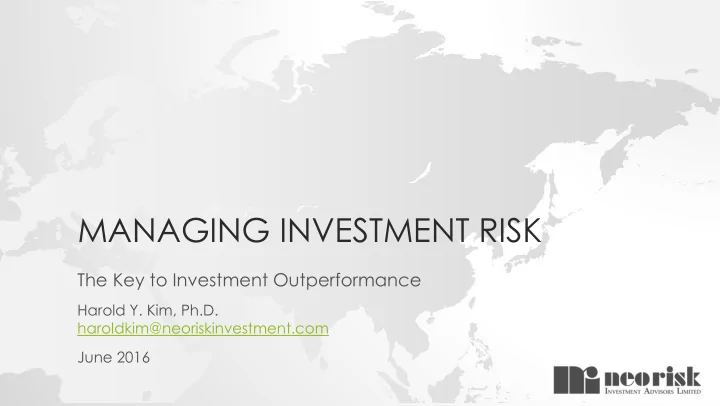

MANAGING INVESTMENT RISK The Key to Investment Outperformance Harold Y. Kim, Ph.D. haroldkim@neoriskinvestment.com June 2016
AGENDA • The Challenge • What is Risk? What is Risk Management? • Risk-focused Investment Management • Examples: Asian Equity Index
THE CHALLENGE: VOLATILE PRICES 3 100 200 300 400 500 600 700 0 1987 1988 1989 1990 1991 1992 1993 MSCI Asia ex-Japan Index 1987-2016 1994 1995 1996 1997 1998 Source: Bloomberg 1999 2000 2001 2002 2003 2004 2005 2006 2007 2008 2009 2010 2011 2012 2013 2014 2015
THE CHALLENGE: CHANGING RISK 4 10% 20% 30% 40% 50% 60% 70% 0% 1987 1988 1989 1990 1991 1992 1993 MSCI Asia ex-Japan Volatility 1987-2016 1994 1995 1996 1997 1998 1999 Source: Bloomberg 2000 2001 2002 2003 2004 2005 2006 2007 2008 2009 2010 2011 2012 2013 2014 2015
WHAT IS RISK? • Risk – uncertainty of investment returns • Investor categories • Low risk • Medium risk • High risk 5
WHAT IS RISK MANAGEMENT? • Risk management – managing (reducing) uncertainty of investment returns 4.5% 4.0% 3.5% 3.0% Probability 2.5% 2.0% 1.5% 1.0% 0.5% 0.0% -70 -66 -62 -58 -54 -50 -46 -42 -38 -34 -30 -26 -22 -18 -14 -10 -6 -2 2 6 10 14 18 22 26 30 34 38 42 46 50 54 58 62 66 70 74 78 82 86 90 Return
RESPONDING TO CHANGES IN RISK • What if equity risk doubles? Utility 100% Function 100% 3 Equity Equity Utility Function 1 Expected Return 30% Equity 100% Bonds Utility Function 2 Volatility 7
RISK-FOCUSED INVESTMENT MANAGEMENT • Risk-focused investment management – investing with emphasis on managing risk to acceptable (optimal) levels • Risk management tools include: • Dynamic asset allocation • Diversification • Hedging • Derivatives
EXAMPLE 1: TARGET VOLATILITY Systematically adjusting equity • exposure to manage risk Improved return-risk ratio • Dynamic asset allocation • Benchmark Target Vol (15%) Ann. Rtn 7.3% 6.1% Index: MSCI Asia Ex-Japan Source: Bloomberg and Neo Risk Investment Advisors Ann. Vol 21.1% 13.5% Info Ratio 0.34 0.46 Skew (0.29) (0.49) 7.22 1.93 Kurtosis Max Drawdown -65.5% -39.8%
EXAMPLE 2: TARGET VOL 2.0 Optimizing for risk characteristics • of Asian equity market Higher returns with lower volatility, • resulting in higher return-risk ratio Benchmark Base Risk Model *Benchmark: MSCI Asia Ex-Japan Index Ann. Rtn 7.3% 9.2% +Model returns are after management fees and transactions costs Source: Bloomberg and Neo Risk Investment Advisors Ann. Vol 21.1% 14.4% Info Ratio 0.34 0.64 Skew (0.29) (0.12) Kurtosis 7.22 3.60 Max Drawdown -65.5% -38.9%
EXAMPLE 3: EFFECTIVE HEDGING Risk-based diversifying hedge • overlay Designed to be more effective as • risk increases Correlation with Benchmark -65% • Benchmark Hedge Portfolio *Benchmark: MSCI Asia Ex-Japan Index Ann. Rtn 7.3% 4.3% +Model returns are after management fees and transactions costs Source: Bloomberg and Neo Risk Investment Advisors Ann. Vol 21.1% 9.9% Info Ratio 0.34 0.44 Skew (0.29) (0.06) Kurtosis 7.22 3.11 Max Drawdown -65.5% -20.2%
EXAMPLE 4: ASIA REAP PORTFOLIO Combining Target Volatility 2.0 • and Effective Hedging Dramatic improvement in returns • with lower risk and drawdown Benchmark Asia REAP Portfolio *Benchmark: MSCI Asia Ex-Japan Index Ann. Rtn 7.3% 14.1% +Model returns are after management fees and transactions costs Source: Bloomberg and Neo Risk Investment Advisors Ann. Vol 21.1% 12.1% Info Ratio 0.34 1.17 Skew (0.29) (0.16) Kurtosis 7.22 2.70 Max Drawdown -65.5% -25.2%
PERFORMANCE BY YEAR: RETURN • Outperformance driven by Return by Year asymmetric response to 60% up/down markets 40% • Large outperformance during 20% weak markets • Marginal underperformance 0% 2005 2006 2007 2008 2009 2010 2011 2012 2013 2014 2015 during strong markets -20% -40% -60% -80% Benchmark REAP *Benchmark: MSCI Asia Ex-Japan Index +Model returns are after management fees and transactions costs Source: Bloomberg and Neo Risk Investment Advisors
PERFORMANCE BY YEAR: VOLATILITY • Impact of active risk Volatility by Year management evident 40% • Compare Benchmark vs REAP 35% portfolio volatility 30% 25% 20% 15% 10% 5% 0% 2005 2006 2007 2008 2009 2010 2011 2012 2013 2014 2015 Benchmark REAP *Benchmark: MSCI Asia Ex-Japan Index +Model returns are after management fees and transactions costs Source: Bloomberg and Neo Risk Investment Advisors
OUTPERFORMING IN WEAK MARKETS Ten Worst Monthly Returns for Benchmark during Sample Period • Large outperformance 2005-2015 Month Benchmark* Base Risk Hedge Asia REAP during weak markets Model Portfolio Oct-08 -27.5% -5.1% 3.5% -1.4% • Target volatility (BRM) manages overall risk level Sep-08 -18.1% -5.8% 2.7% -3.0% Jan-08 -14.9% -8.9% 3.7% -4.9% • Hedge portfolio delivers positive (diversified) returns Sep-11 -14.1% -5.8% 4.9% -0.7% Jun-08 -12.7% -6.3% 4.0% -2.1% Aug-11 -10.4% -6.3% 5.0% -1.0% Aug-15 -10.3% -7.1% 1.6% -5.4% May-12 -10.1% -7.8% 2.8% -4.8% Nov-07 -8.9% -7.3% 0.7% -6.6% May-10 -8.8% -5.0% 3.0% -1.8% *Benchmark: MSCI Asia Ex-Japan Index +Model returns are after management fees and transactions costs Source: Bloomberg and Neo Risk Investment Advisors
SUMMARY • Volatile market movements presenting challenges to investing • Risk-focused investment management required to deliver optimal results for investors • Asymmetric response to positive/negative markets adds value • Smoothed returns, smaller drawdowns, overall outperformance This communication is provided for information and discussion purposes only and does not constitute a recommendation or an offer to sell or a solicitation to buy any financial product or enter into any transaction. This communication is directed exclusively at market professionals, financial intermediaries and institutional investor customers and is not intended for distribution to retail customers. The information contained in this communication is based on generally available information, and although obtained from sources believed by to be reliable, the accuracy and completeness of the information cannot be assured, and such information may be incomplete or condensed.
Recommend
More recommend